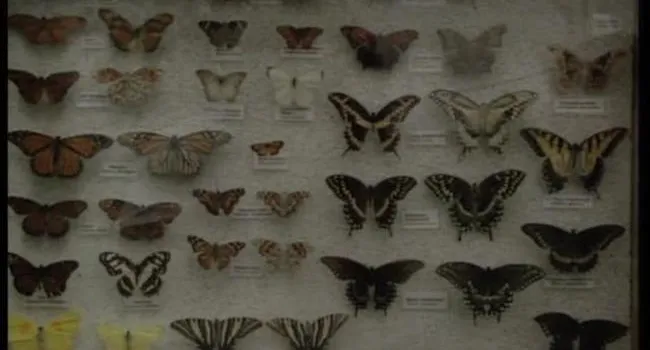Riverbanks Zoo and Botanical Garden in Columbia, South Carolina, is one of the leading zoos in the country. When Project Discovery visited this zoo, animals from apes to zebras were on display. The zoo was constructed to simulate the animals’ natural habitat.
In the elephant barn, the elephant keeper tells about the elephants and how they are cared for at the zoo. An elephant trainer makes it easier to take care of the animals because they obey his commands. When it is time for a bath, the elephant lies down. In zoo settings, elephants need baths to remove the dead skin from their backs. In the wild, elephants rub against trees to remove this skin. Both of the elephants at Riverbanks are African elephants, the largest land mammals in the world. African elephants have large ears that are shaped somewhat like the continent of Africa and can, therefore, be distinguished from Asian elephants, which have smaller ears. One of the elephants is 26 years old, which is actually a very young elephant since elephants can live to be 50 to 60 years old. She weighs about 8,000 pounds. The 16-year-old elephant is still growing and weighs about 5,500 pounds. The elephants are weighed each year on truck scales. In captivity, an elephant’s feet have to be trimmed and filed. Their tusks are like front teeth. Elephants have six sets of teeth, which need to eat 200 pounds of hay each day. They also drink about 300 gallons of water per day. They lay down at night to sleep, but they can rest standing up with their eyes closed.
Behind the scenes in the reptile propagation area, we see chameleons and other reptiles. A curator is the manager of a certain type of animal exhibit. The curator of reptiles explains that, in this area, baby reptiles are hatched, sick reptiles are cared for, and other reptiles, which are not currently on display, are housed. Tortoise eggs are kept in an incubator until they hatch. Baby reptiles look exactly like their parents, except that they are smaller. A tortoise can live 200 years and grow to be very big. Chameleons become adults in less than a year and have babies at that time. Different reptiles are kept separate to avoid stress on the animals. Snakes also lay eggs, but these eggs are all laid in one big clump, and they stick together until they hatch. Many of the reptiles can be handled and touched, unlike the larger mammals in the zoo. Snakes really like small spaces; therefore, they are kept in small cages. A card is kept on each reptile. For the venomous reptiles, the cards are color coded in case someone is bitten. The proper antidote for the poison can be quickly selected based on the color code of the card. At the aquarium, food for each fish is prepared. Some fish eat shrimp, squid, and other fish. Some of the fish eat plants and are fed vegetables and plants. A diver goes into the coral reef tank to feed the fish. The smaller fish eat twice a day; some of the larger fish eat only once or twice a week.
Standards
- Life Science: Environments and Habitats
- 3.L.5 The student will demonstrate an understanding of how the characteristics and changes in environments and habitats affect the diversity of organisms.
- 3.L.5A The characteristics of an environment (including physical characteristics, temperature, availability of resources, or the kinds and numbers of organisms present) influence the diversity of organisms that live there. Organisms can survive only in...
- 3.L.5A.1 Analyze and interpret data about the characteristics of environments (including salt and fresh water, deserts, grasslands, forests, rain forests, and polar lands) to describe how the environment supports a variety of organisms.
- 3.L.5A.2 Develop and use a food chain model to classify organisms as producers, consumers, and decomposers and to describe how organisms obtain energy.
- 3.L.5A The characteristics of an environment (including physical characteristics, temperature, availability of resources, or the kinds and numbers of organisms present) influence the diversity of organisms that live there. Organisms can survive only in...
- 3.L.5 The student will demonstrate an understanding of how the characteristics and changes in environments and habitats affect the diversity of organisms.
- Life Science: Exploring Organisms and the Environment
- K.L.2 The student will demonstrate an understanding of organisms found in the environment and how these organisms depend on the environment to meet those needs.
- K.L.2A The environment consists of many types of organisms including plants, animals, and fungi. Organisms depend on the land, water, and air to live and grow. Plants need water and light to make their own food. Fungi and animals cannot make their own ...
- K.L.2A.1 Obtain information to answer questions about different organisms found in the environment (such as plants, animals, or fungi).
- K.L.2A.3 Develop and use models to exemplify how animals use their body parts to
- K.L.2A.5 Construct explanations from observations of what animals need to survive and grow (including air, water, nutrients, and shelter).
- K.L.2A.6 Obtain and communicate information about the needs of organisms to explain why they live in particular areas.
- K.L.2A The environment consists of many types of organisms including plants, animals, and fungi. Organisms depend on the land, water, and air to live and grow. Plants need water and light to make their own food. Fungi and animals cannot make their own ...
- K.L.2 The student will demonstrate an understanding of organisms found in the environment and how these organisms depend on the environment to meet those needs.



































